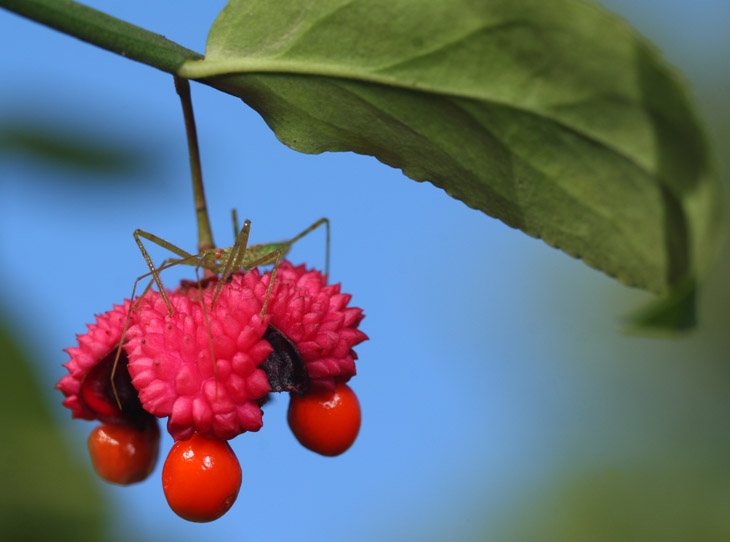I said in the previous post that more would be coming “in a day or so” after I worked out some details. “Or so” apparently means “five days.” However, that’s nowhere near how long I’ve been waiting.
Back in 2010, I snagged a pair of images of a small unknown insect, one that flew away before I could do anything detailed, and this was before I had the macro options I do now. On examining the images during sorting, I realized I’d never seen anything of the like; it looked like a cross between a lacewing and a praying mantis, less than a centimeter in length.
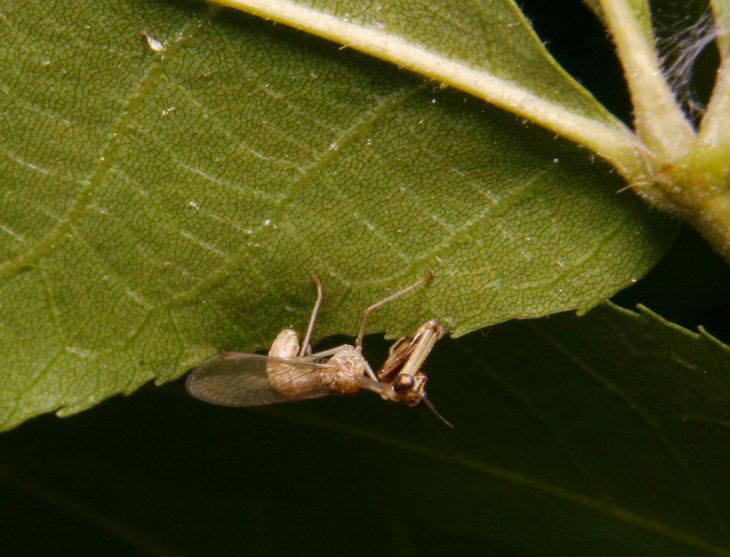
Without a lot to search on, I tried just using the term “mantis fly” and popped it up immediately. Almost certainly a member of the family Mantispidae, this one might well be a green mantisfly (Zeugomantispa minuta,) though the guide page doesn’t give a range of sizes; since this one had wings, I’m assuming it was a reproducing adult and not a larva. I have not seen one since – until, I thought, the other evening.
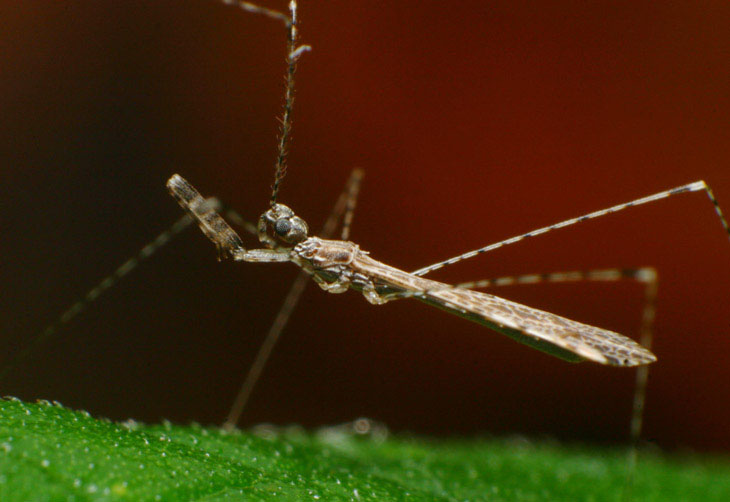
I pootered this one circling the light and was delighted when I examined it, because I thought I’d finally found another example of a mantisfly. Getting the preliminary photos was a challenge, because this one was about the size of a mosquito and showed no reluctance in flying off, so it would have to be in some kind of enclosure. Unfortunately, the only enclosure I had that would work for the short working distance of this magnification was already in use, as a terrarium housing the very spiders that this guy was initially captured to feed. I ended up lying another small aquarium on its side and shining a bright light in from the top, because I’m sneaky; while the side (formerly top) through which I was aiming the camera was wide open, the insect was attracted to the light so the two times it tried to fly off, it simply went against the acrylic above it (former side) and returned to the leaf. After the initial shots, I popped it into the spider terrarium while I tried to figure out a way to handle this more effectively.
The terrarium only has a thin bit of gauzy fabric stretched over the top, which I thought was sufficient – this post is full of mistaken assumptions. Overnight my subject disappeared, and on a subsequent night I watched several other small insects simply crawl through the openings in the fabric, so that needs to be replaced with something much finer, probably a bit of silkscreen. In the meantime I picked up four 5×7 frames from the dollar store and used the glass to make a 5x5x7 enclosure strictly for photography, and a few pieces of glass to modify other aquariums I have, because acrylic is absolute shit to shoot through. And finally, just now, I sat down to write this up and dig out the old photo you saw at top.
If you thought they looked significantly different, good eye: they’re not related, and the latter one is certainly not a mantisfly. It’s a variety of threadlegged assassin bug, indicated easily by the proboscis on the head; possibly tribe Metapterini, of the subfamily Emesinae from the family Reduviidae (of the clan Macleod – sorry.) Another variety can be seen here.
So, abruptly, I crashed into disappointment strictly from working on this post – I’m going to go ahead and blame that on you if you don’t mind. But while looking through BugGuide.net for further details on the still-elusive mantisflies, I came across this photo (part of a series that provides positive identification,) which looked remarkably familiar, so now it seems I have at least identified those eggs and larvae. This, however, is also a facet of frustration because it means that I had a hatching of the very subject I’d been looking for and didn’t realize it, nor did I ever see an adult.
Now, while searching back through the photo archives to find that mantisfly, I came across the next few images which reminded me of something I’d forgotten about. In my old place, I had an inkjet printer sitting on a hutch atop my desk, before I determined that they were complete wastes of technology and effort and switched to a laser printer, never to return. And one day I glanced up casually to come face-to-face with a spider peering at me from the print delivery slot.
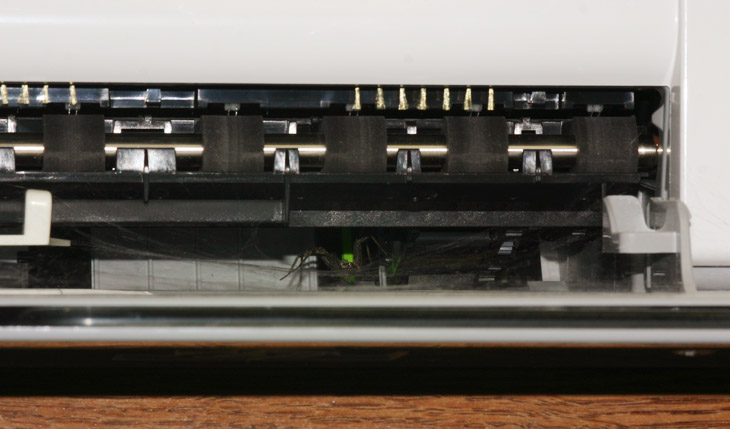
This was some variety of funnel weaver, family Agelenidae, and you may well take this as a reflection of either my sporadic printer use or my terrible housekeeping abilities or perhaps that I lived in something akin to a shed, but it was none of those things. It was high summer, and yes I lived alongside a wooded area, but overall the place was clean and not overrun with spiders; this one has simply found its way in and liked the printer for some reason, and while I can’t pin down a particular time frame from when I could confirm it had not been there, this may have happened literally overnight.
The nature of funnel weavers is that they create a large horizontal sheet web that rolls up in one corner into a tube or funnel, usually in a natural niche someplace, and within this tube they spend most of their time, hidden away from predators while awaiting something to fall into their web. At times you may see one sitting out in the open sheet, but most times it will vanish into the tube at the least provocation, and the one on my desk was definitely disposed to this behavior, disappearing deep into the guts of the printer. I wasn’t really inclined to leave it there, and will readily admit that I was more than a little creeped out on my initial encounter. But how to remove it?
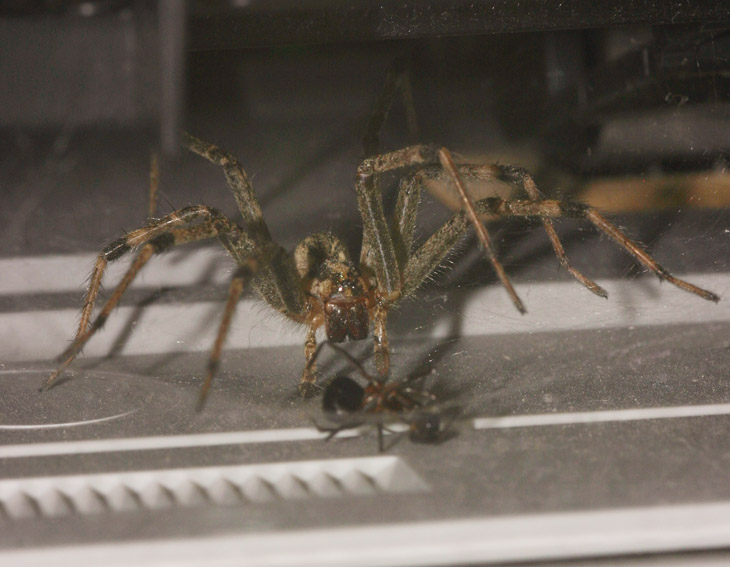
It didn’t take long. All I did was go out and collect a live ant to throw into the sheet, and in a flash, the spider emerged triumphantly to partake of this free meal, no doubt congratulating itself on the choice homebuilding locale. This delight was short-lived, however, because immediately after I got the photos, the shop-vac came into play before the spider could retreat away from the effective suction, and my printer was clean once again.
Getting back to the subject of flying insects and macro photography, this is something I’ve struggled with for years. Any time something can fly away, naturally getting macro photos is tricky; depending on the focal length and magnification, you might have to loom very close, and this can be enough to provoke the subject to fly off, or it may simply do so because it has no desire to march around on whatever leaf you provided. The goal is to have an enclosure where it cannot escape, and in times past I have used the bathroom (small enough to find the subject again – sometimes) and a variety of aquariums/terrariums. Since acrylic will seriously affect image quality and scratches if you breathe on it, you’ll want glass – but you also want a very short working distance so the subject cannot simply move far enough from the glass that you can’t get the magnification you’re after. This means smaller enclosures, like the 5x5x7 one I mentioned (right now just an open box that can be placed over anything, and sealed off on top by screen or another piece of glass or a book or whatever,) and perhaps even smaller – the one I’m about to modify measures something like 5×7 inches broad by about 1 inch deep, and of course there’s this one that currently houses the spiders.
It would be far better without any glass at all, since even a good piece of glass will offer some distortion if you’re not shooting straight through it, but that means some kind of booth or hood that seals off both you and the flying subject so they can’t get very far, and setting up something like that could be problematic (not to mention finding a place to put it.) Maybe someday I’ll attempt using a large wardrobe or a closet, but right now I have nothing of the sort available. But keep checking back, because I’ll be testing out the new options soon enough.






















































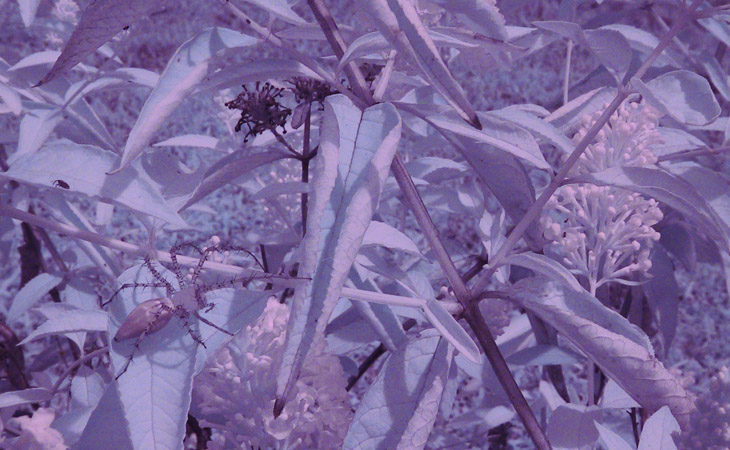
 We are rapidly approaching ‘peak’ autumn color season here in this section of NC, which is slightly misleading in a couple of ways. First off, peak is different depending on latitude, humidity, and the conditions that the trees were in throughout the summer, so you never have to go very far to find different color conditions. Second, the trees all change at different times and different rates, so each species has its own time for brightest colors, and the best that anyone can aim for (if they’re looking for broad landscapes anyway,) are periods where the greatest number of species visible are closest together in ideal color. Obviously there’s a challenge to this, compounded by the bare fact that a good wind or rain storm near such times can wipe all the leaves from the trees. However, if you’re selective and go for smaller compositions rather than something like an entire hillside, you can shoot ‘peak’ colors for weeks.
We are rapidly approaching ‘peak’ autumn color season here in this section of NC, which is slightly misleading in a couple of ways. First off, peak is different depending on latitude, humidity, and the conditions that the trees were in throughout the summer, so you never have to go very far to find different color conditions. Second, the trees all change at different times and different rates, so each species has its own time for brightest colors, and the best that anyone can aim for (if they’re looking for broad landscapes anyway,) are periods where the greatest number of species visible are closest together in ideal color. Obviously there’s a challenge to this, compounded by the bare fact that a good wind or rain storm near such times can wipe all the leaves from the trees. However, if you’re selective and go for smaller compositions rather than something like an entire hillside, you can shoot ‘peak’ colors for weeks.
 Last weekend was even harder, as the colors were sparse and widely separated, so a lot of selectivity and careful framing was in order – even though only two thin trees are producing color here, the angle made the most of them within the frame, and the stump formed the primary point of focus so the colors just kind of fill out the background as the setting. The sky was too clouded to provide any color itself, so the muted light is communicating the grey fall day thing, and you can see that the colors on the ground aren’t anything to write home (or a post) about. However, after getting back and seeing how this frame turned out, I realized I could have changed my angle only slightly and made that cluster of thicker trunks appear almost to ‘sprout’ from the stump, nicely aligned with the sides. I hate it when I get creative after the fact…
Last weekend was even harder, as the colors were sparse and widely separated, so a lot of selectivity and careful framing was in order – even though only two thin trees are producing color here, the angle made the most of them within the frame, and the stump formed the primary point of focus so the colors just kind of fill out the background as the setting. The sky was too clouded to provide any color itself, so the muted light is communicating the grey fall day thing, and you can see that the colors on the ground aren’t anything to write home (or a post) about. However, after getting back and seeing how this frame turned out, I realized I could have changed my angle only slightly and made that cluster of thicker trunks appear almost to ‘sprout’ from the stump, nicely aligned with the sides. I hate it when I get creative after the fact… Suspended in the middle distance over a significant dropoff, I wasn’t going to get very close to this one, so I settled for capturing its subtle presence against the backdrop of the beginning autumn colors, managing to get a hint of the orb web in the image. Marbled orb weavers (Araneus marmoreus) seem to be conflicted: visible here and in that previous linked shot, they have very high visibility markings with the banded legs and the brilliant body colors, which is nature’s way of saying, “Back off!” without having the evolve little Yosemite Sam mudflaps, but they depend on their webs not being obvious in order to feed at all. To the best of my knowledge, flying insects take no note of their colors nor the curious ability to hover in midair apparently unsupported, and thus blunder into the webs, but the birds which might consider them a (sizable) tasty meal are alerted by the incongruous contrast and position. It’s one of those funny things, because like the
Suspended in the middle distance over a significant dropoff, I wasn’t going to get very close to this one, so I settled for capturing its subtle presence against the backdrop of the beginning autumn colors, managing to get a hint of the orb web in the image. Marbled orb weavers (Araneus marmoreus) seem to be conflicted: visible here and in that previous linked shot, they have very high visibility markings with the banded legs and the brilliant body colors, which is nature’s way of saying, “Back off!” without having the evolve little Yosemite Sam mudflaps, but they depend on their webs not being obvious in order to feed at all. To the best of my knowledge, flying insects take no note of their colors nor the curious ability to hover in midair apparently unsupported, and thus blunder into the webs, but the birds which might consider them a (sizable) tasty meal are alerted by the incongruous contrast and position. It’s one of those funny things, because like the 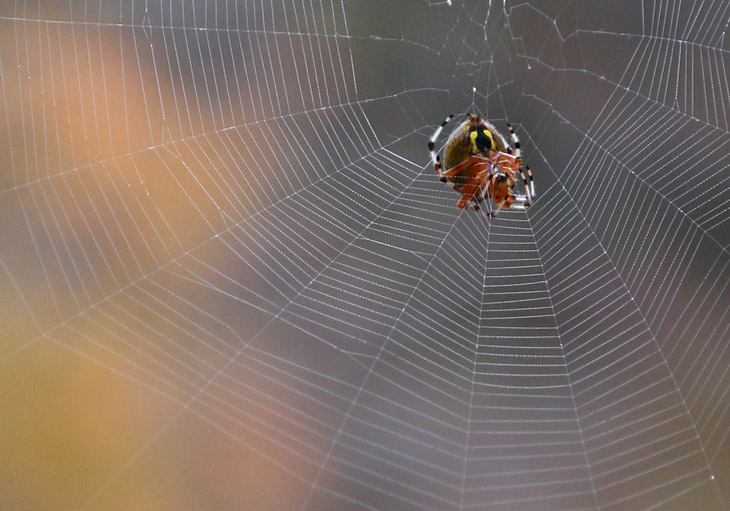
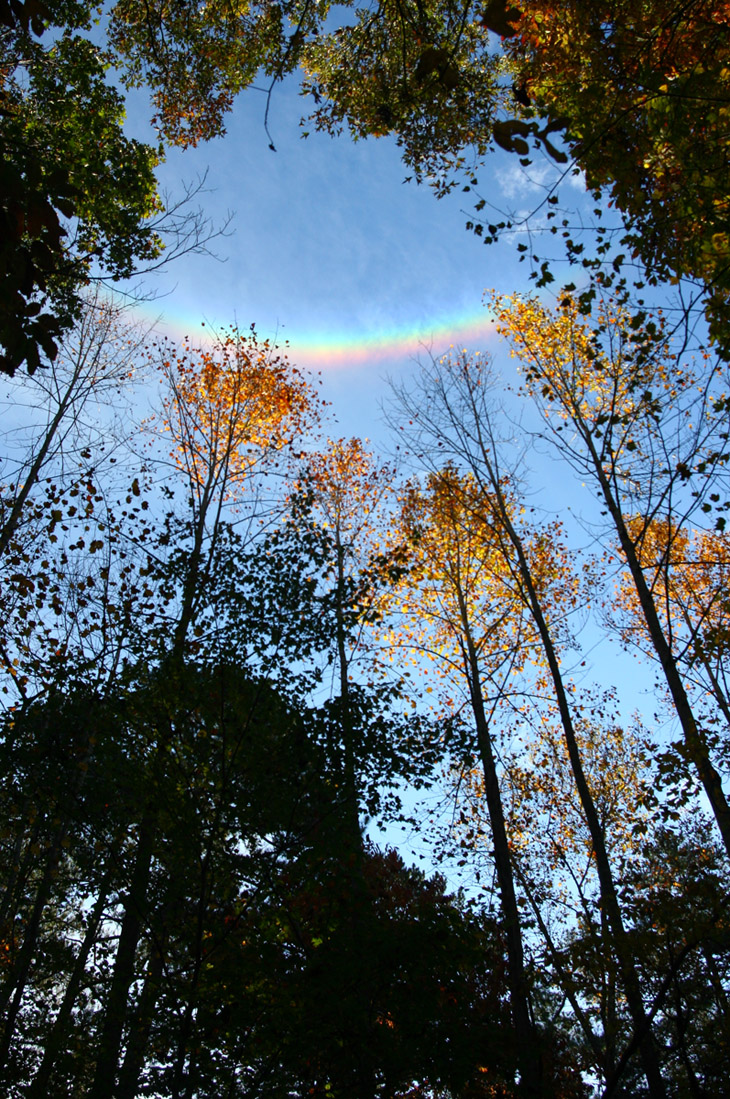
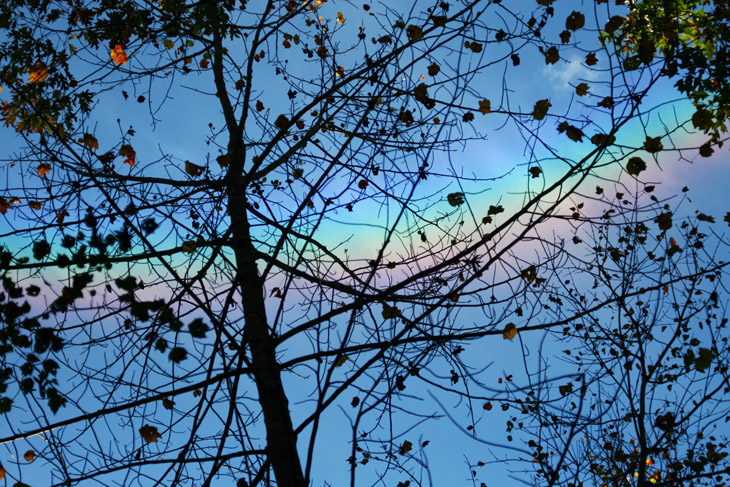
 Now for a bit of trivia. While shooting this, I had the presence of mind not just to try and frame the sun with the arc for comparative purposes, but to note the time of day and the relative positions of both sun (bursting through the trees near the bottom of the image) and arc, because at that time I didn’t even know what a circumzenithal arc was. I could only estimate the altitude of the sun and arc, but figured 30° for the sun and 75-80° for the arc. Later on as I looked up details, I found a source that said that the arc is usually about 46° above the sun. Naturally, I pumped my fist in the air and whooped and did all of those other egotistical guy things (EGTs.) But then, with some playing around with Stellarium and the view-angles I should have been getting from the lens, I ended up with the sun at 20° and the arc at 59° – wasted those whoops, it seems. Though I’m skeptical, because I would swear that the arc was higher. The site that I just linked to, by the way, says that the best times to see such arcs is when the sun is around 22° in altitude, so that lines up, at least…
Now for a bit of trivia. While shooting this, I had the presence of mind not just to try and frame the sun with the arc for comparative purposes, but to note the time of day and the relative positions of both sun (bursting through the trees near the bottom of the image) and arc, because at that time I didn’t even know what a circumzenithal arc was. I could only estimate the altitude of the sun and arc, but figured 30° for the sun and 75-80° for the arc. Later on as I looked up details, I found a source that said that the arc is usually about 46° above the sun. Naturally, I pumped my fist in the air and whooped and did all of those other egotistical guy things (EGTs.) But then, with some playing around with Stellarium and the view-angles I should have been getting from the lens, I ended up with the sun at 20° and the arc at 59° – wasted those whoops, it seems. Though I’m skeptical, because I would swear that the arc was higher. The site that I just linked to, by the way, says that the best times to see such arcs is when the sun is around 22° in altitude, so that lines up, at least… I finish off with another selective composition, because the tiny sapling venturing from a hole in the tree trunk was interesting enough, more so with the color. It wasn’t much later than this that the humidity built too high and the light conditions descended into heavy haze, dropping the wooded areas into deeper shade and destroying any chances for colorful backlighting. But we got enough frames for the day, I’m thinking.
I finish off with another selective composition, because the tiny sapling venturing from a hole in the tree trunk was interesting enough, more so with the color. It wasn’t much later than this that the humidity built too high and the light conditions descended into heavy haze, dropping the wooded areas into deeper shade and destroying any chances for colorful backlighting. But we got enough frames for the day, I’m thinking.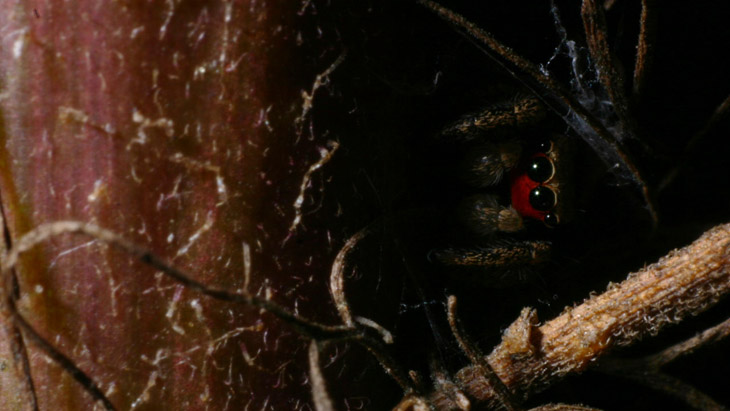

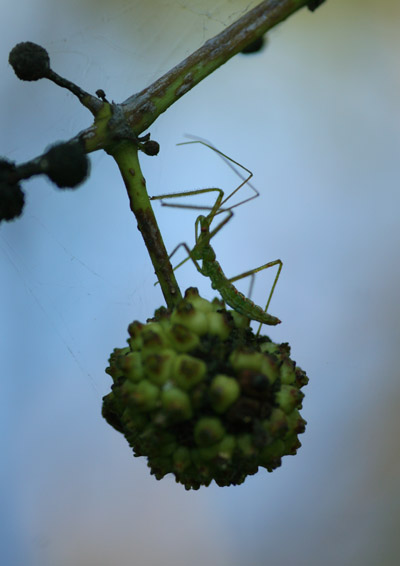 Over at the pond nearby, a pale green assassin (Zelus luridus) like the one seen a few posts back posed in shadow on the pod of a buttonbush (Cephalanthus occidentalis.) While I’ve been seeing them from the start of the insect season this year, for some reason I’ve been seeing more of them recently, and mostly in nymph form – this is telling me that their birthing period does not seem to be linked to seasons. My initial go-to source of arthropod info, BugGuide.net, has
Over at the pond nearby, a pale green assassin (Zelus luridus) like the one seen a few posts back posed in shadow on the pod of a buttonbush (Cephalanthus occidentalis.) While I’ve been seeing them from the start of the insect season this year, for some reason I’ve been seeing more of them recently, and mostly in nymph form – this is telling me that their birthing period does not seem to be linked to seasons. My initial go-to source of arthropod info, BugGuide.net, has 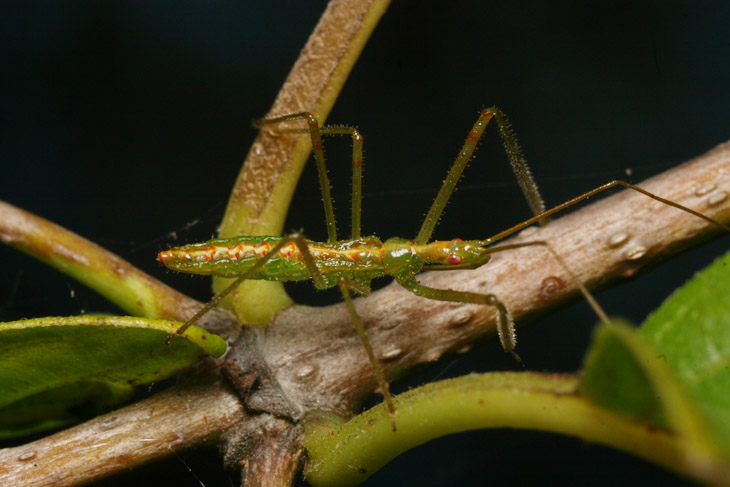
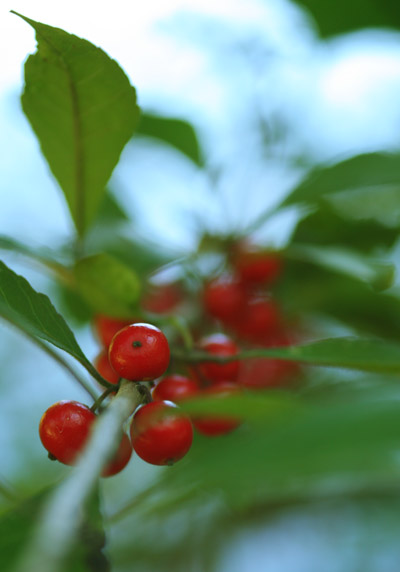 We’re going to gradually turn up the green as we go. In one spot alongside the pond, an unidentified tree was sporting tight clusters of berries, and like the first assassin image above, I picked an angle that would make use of the pond’s surface in the background – again, still working in shade since the light just wasn’t cooperating. An assassin in this composition might have been nice, but noooo, none of them could be found here. Try and make them famous, and this is what you get. Ingrates.
We’re going to gradually turn up the green as we go. In one spot alongside the pond, an unidentified tree was sporting tight clusters of berries, and like the first assassin image above, I picked an angle that would make use of the pond’s surface in the background – again, still working in shade since the light just wasn’t cooperating. An assassin in this composition might have been nice, but noooo, none of them could be found here. Try and make them famous, and this is what you get. Ingrates.
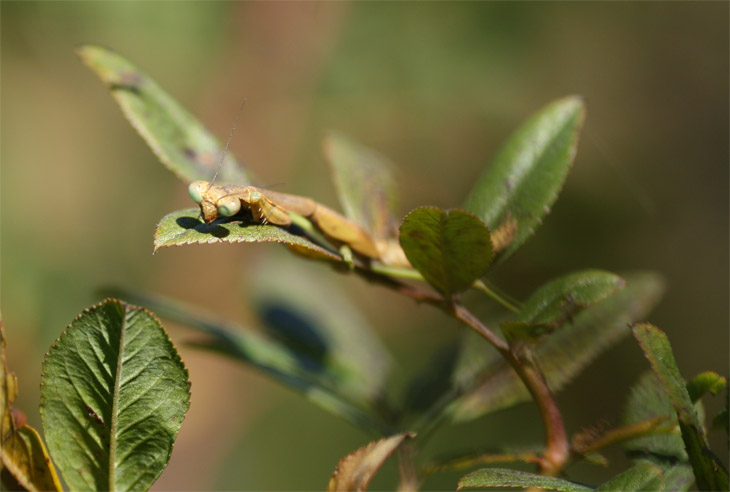
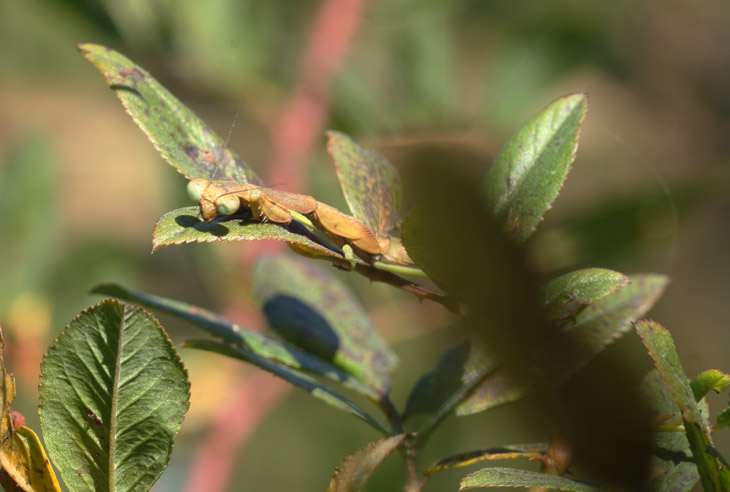
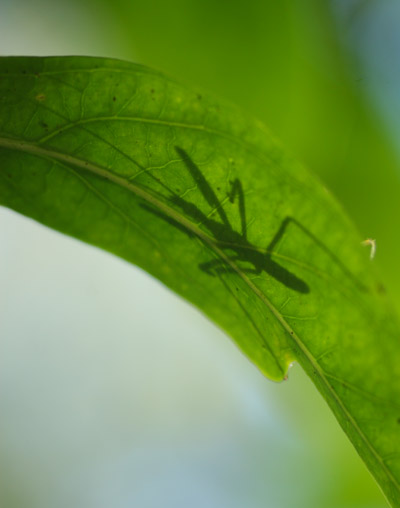 Back in the yard, I found yet another pale green assassin, this time on one of the gardenia bushes. I was just going to ignore it, but while searching for other species I noticed how sharp the shadow was when seen from the underside, and went back in to get the camera again – in the sporadic light of the backyard, I knew the sun could quickly move out of the position where the shadow could even be seen. Yes, that’s the tip of the hind leg peeking out over the leaf edge. I waited a bit to see if the assassin would give me a portrait shot over the edge as well, but like its brethren, it stubbornly moved away from a decent perspective.
Back in the yard, I found yet another pale green assassin, this time on one of the gardenia bushes. I was just going to ignore it, but while searching for other species I noticed how sharp the shadow was when seen from the underside, and went back in to get the camera again – in the sporadic light of the backyard, I knew the sun could quickly move out of the position where the shadow could even be seen. Yes, that’s the tip of the hind leg peeking out over the leaf edge. I waited a bit to see if the assassin would give me a portrait shot over the edge as well, but like its brethren, it stubbornly moved away from a decent perspective.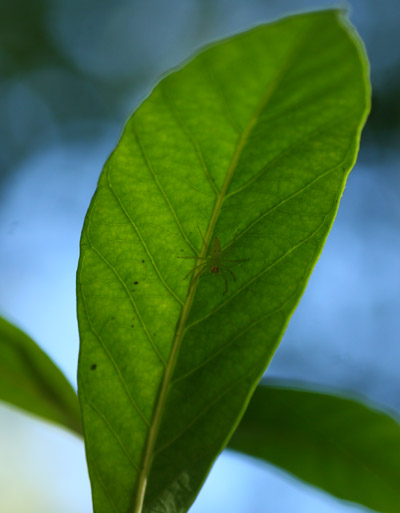 While down there however, I quickly spotted something on a neighboring leaf, this one partially shaded despite being not 20cm away. It was another of my
While down there however, I quickly spotted something on a neighboring leaf, this one partially shaded despite being not 20cm away. It was another of my  The shot above was taken aiming almost straight up, so I sat back up and tried shooting nearly level, edgewise along the leaf, and the spider turned to face me suspiciously. This resulted in a series of images that I combined into an animated gif (pronounced “HEE-la“) – not half as good as the video linked above (or
The shot above was taken aiming almost straight up, so I sat back up and tried shooting nearly level, edgewise along the leaf, and the spider turned to face me suspiciously. This resulted in a series of images that I combined into an animated gif (pronounced “HEE-la“) – not half as good as the video linked above (or  For this week’s Monday color, we rely on the brilliance of Aconitum blossoms, otherwise known by a zillion different names such as monkshood, wolf’s bane, devil’s bane, Queen of All Poisons, and flake attractor, the last of which is my own, coined after seeing the woo-related claims and usages for the plant that can be found online. While purported to have countless different properties over the centuries, the only two that can be supported with any accuracy are a) that the plant is toxic to a fair degree, and b) the flowers are usually colorful. Many medicinal claims have been made for species throughout the botanical kingdom, and most are anecdotal at best; despite the avowals of numerous naturopathic and mystic flakes, science has not ignored such claims at all, but has tested the majority of them under controlled conditions (meaning, not subject to subjectivity, small sample sizes, and the placebo effect.) The few that actually showed dependable results, like salicylic acid and quinine, quickly became known as, “medicine.” Thus, when you hear phrases such as, “alternative medicine,” or, “traditional medicine,” these can easily be translated to, “not even close to medicine.” Just a little pointer to save you some time.
For this week’s Monday color, we rely on the brilliance of Aconitum blossoms, otherwise known by a zillion different names such as monkshood, wolf’s bane, devil’s bane, Queen of All Poisons, and flake attractor, the last of which is my own, coined after seeing the woo-related claims and usages for the plant that can be found online. While purported to have countless different properties over the centuries, the only two that can be supported with any accuracy are a) that the plant is toxic to a fair degree, and b) the flowers are usually colorful. Many medicinal claims have been made for species throughout the botanical kingdom, and most are anecdotal at best; despite the avowals of numerous naturopathic and mystic flakes, science has not ignored such claims at all, but has tested the majority of them under controlled conditions (meaning, not subject to subjectivity, small sample sizes, and the placebo effect.) The few that actually showed dependable results, like salicylic acid and quinine, quickly became known as, “medicine.” Thus, when you hear phrases such as, “alternative medicine,” or, “traditional medicine,” these can easily be translated to, “not even close to medicine.” Just a little pointer to save you some time.
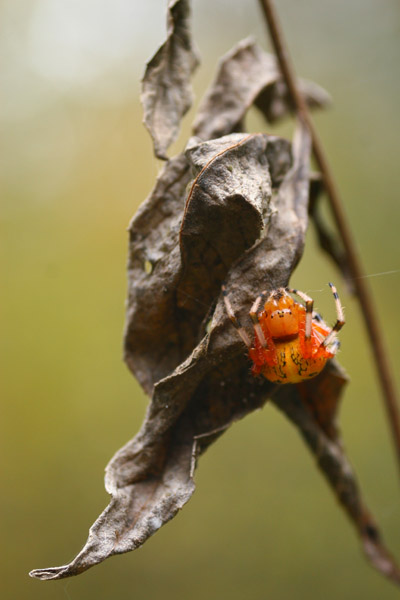 First off, you do know Halloween is coming, right? This little lady seems to…
First off, you do know Halloween is coming, right? This little lady seems to…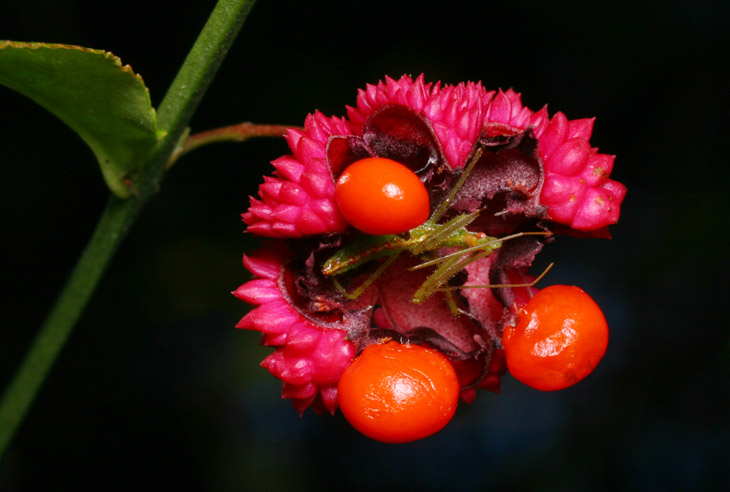
 Able to get a decent angle against the sky with this one, I first did the standard exposure – with the macro rig, I have a fixed exposure at 1/200 second at f16, ISO 200, and the flash output is right in line for this. As before, the bright sky came through with some color, though notably deep. It’s okay, but definitely not a natural look. As I first loomed in close, the assassin went into defensive posture, drawing the legs up as protective bars – this is a common trait with the species, and it often serves to obscure the eyes, which is a no-no for nature photography, so finding the angle where a red compound eye remained visible was important.
Able to get a decent angle against the sky with this one, I first did the standard exposure – with the macro rig, I have a fixed exposure at 1/200 second at f16, ISO 200, and the flash output is right in line for this. As before, the bright sky came through with some color, though notably deep. It’s okay, but definitely not a natural look. As I first loomed in close, the assassin went into defensive posture, drawing the legs up as protective bars – this is a common trait with the species, and it often serves to obscure the eyes, which is a no-no for nature photography, so finding the angle where a red compound eye remained visible was important.
